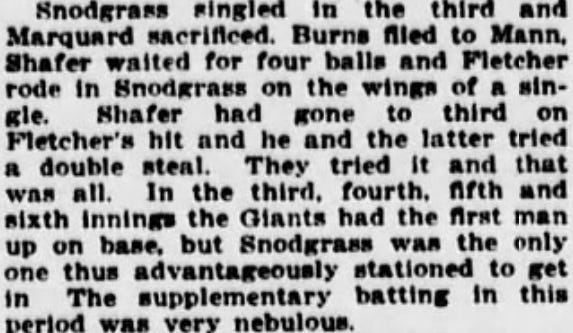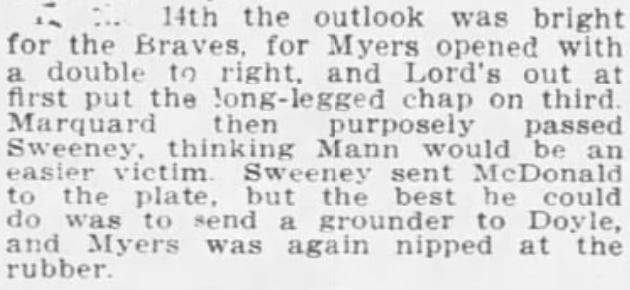What Baserunning Was Like In The Deadball Era
The Deadball Era was different, that’s for sure.
I was interested in looking at what baserunning was like in 1913. And I came across a pretty interesting statistic on Baseball Reference:
With nearly 3,000 stolen base attempts, the National League had a successful stealing percentage of only 57%.
I don’t know if that’s the lowest in history or not. I do know that the raw numbers are likely low, since Retrosheet has only collected play by play data for about 70% of the 1913 games.
However, this struck me as pretty interesting. Lots of guys were getting thrown out on the bases, for sure. And so I decided to look at a double header to see what was happening.
On Labor Day, September 1, the Boston Braves went to the Polo Grounds to face the New York Giants for a traditional doubleheader.
The Giants came into this game in first place and were cruising towards the pennant. The Braves, on the other hand, were heading for the wrong end of .500:
This was one of those old fashioned morning and afternoon doubleheaders:
It looks like the first game started at 10:15, and the second at 2. There were two different gates, which was customary for holiday doubleheaders in those days.
And, in the first game alone, it seemed that neither team could keep itself from running out of good situations.
Art Fletcher of the Giants was caught trying to steal second with two men out in the bottom of the first.
Guy Zinn of the Braves was caught trying to steal second with two out in the top of the second.
With the bases loaded in the bottom of the 9th of a tie ballgame, Art Fletcher was caught trying to steal home. There were two men out at the time. This was a bizarre play:
And then finally, of all things, the winning run scored on a double steal with runners on first and third:
The second game featured even more wild baserunning:
Bris Lord of the Braves was picked off first base in the top of the first with two men out.
Bill Sweeney then stole second in the top of the second after leading off the inning with a single. He advanced to third on a bad throw.
Art Fletcher and Tillie Shafer tried the old double steal in the bottom of the third, but Shafer was caught trying to score:
Rabbit Maranville and Hap Myers tried a double steal in the top of the 8th that turned into a strike ‘em out throw ‘em out double play:
With two men out in the top of the 10th, Maranville was picked off first base:
Then, with two men out in the bottom of the 11th, Larry Doyle was picked off first, but wound up being safe on an error:
Guy Zinn for Boston was caught trying to steal second in the top of the 12th.
George Burns for the Giants was caught trying to steal second in the bottom of the 13th. Tillie Shafer then successfully stole second, but Art Fletcher ground into the third out.
With one out and runners on first and third in the top of the 14th, Les Man hit a ground ball to second. Hap Myers tried to score from third but was a dead duck:
It all ended with a Fred Merkle triple followed by a single to score him:
In 24 innings of baseball, the Braves and Giants combined for 7 times caught stealing and 6 stolen bases. 3 more baserunners were picked off base.
That’s the kind of baseball we’re missing. Maybe we should deaden the ball, force players to use thicker bats, and move the fences back.
















I've wondered whether the players and managers of that era were just playing the way they always had, or whether they really felt that it was so difficult to score after reaching first base that a near 50-50 chance of stealing was a productive move. (Then again, many of the steal attempts you described came with two out. They might have been right in thinking that the chance of getting two singles before another out was recorded was even less than a 50-50 steal chance and one single.)
This post is hilarious, it makes me want to roll a season from the deadball era. Time to add another APBA set.